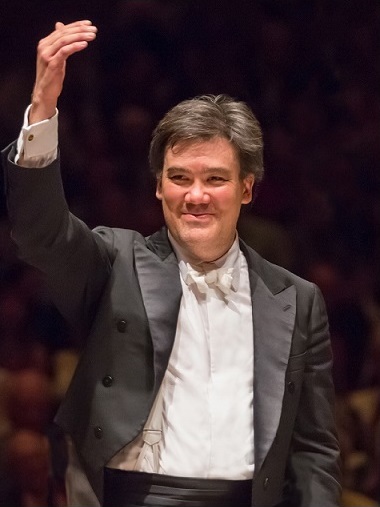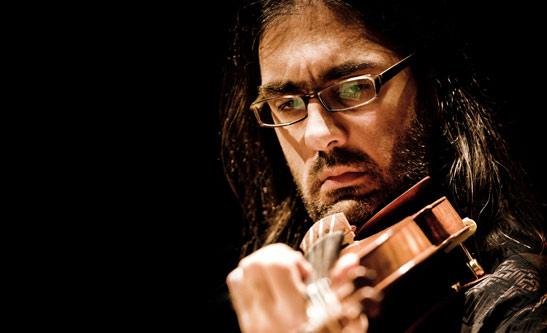Gilbert creatively disrupts concert tradition with the Philharmonic

Alan Gilbert conducted the New York Philharmonic in music of Brahms, Salonen and Thorvaldsdóttir Friday night at David Geffen Hall.
One of the most striking things about Friday night’s New York Philharmonic concert was the program order: Brahms’ Violin Concerto first, followed by recent works by Anna Thorvaldsdóttir and Esa-Pekka Salonen. Conventional wisdom dictates that the “difficult” pieces (usually newish) be performed first, to ensure that an audience remains for the (not so new and more beloved) fare afterward. So conductor Alan Gilbert’s programming was a welcome surprise.
In the long orchestral introduction of the Brahms, the leadership of concertmaster Frank Huang continued to impress. The violins had richness and precision—not that they didn’t previously, but it’s more noticeable now, and has impacted the other string sections. And the sound from everyone else was as finely balanced as can be expected in the fickle acoustic of David Geffen Hall.

Leonidas Kavakos
The soloist, Leonidas Kavakos showed introspection and grace, and his understated approach was evident from his entrance: sweet intonation and mellow double stops, with the orchestra in pillows of old-world elegance. Kavakos offered shrewdly judged contrasts: occasional deliberately anemic episodes made the showier, more passionate ones leap into the foreground as heroic solo lines sailed over the ensemble. The first movement ended with a breathtaking account of Joseph Joachim’s cadenza, done with firm assurance.
In the central Adagio, the violinist was notable for his intonation and quietude in the instrument’s higher registers. And when he was momentarily at rest, he turned to listen to his colleagues: in this case, a wind choir topped by Liang Wang’s mellifluous oboe.
The gypsy spirit of the finale jumped out with fierce authority, as Gilbert elicited light playfulness from the ensemble. Solo Bach made a suave encore.
As Anna Thorvaldsdóttir wrote in her program note, “Aeriality can be said to be on the border of symphonic music and sound art.” The Icelandic composer is often inspired by nature—not surprising, given the mystery and beauty of her country’s landscape—and uses the orchestra to portray vast, slow-moving elements of water, wind, rocks.
After a granitic unison opening in the strings—embellished by piano, flute and harp—the sustained timbres resemble a slow-moving lava flow, glittering with sparks.
While the pace isn’t as glacial as say, Morton Feldman, Thorvaldsdóttir’s score evolves slowly, deliberately, in a constant surge of sound. (As Gilbert remarked, “There are no rests.”)
As the score continues, textures continually undergo transformations, creating unexpected timbres. It’s the sonic equivalent of Google Earth: as a camera zooms in closer to the planet, more details come into view. Sudden accents scrape the surface: tiny chatters of wooden sticks mingle with scraps of cymbal brushes. Bubbling flutes arrive, only to vanish among clouds of strings. Near the end, another unison appears, slashed by double bass accents, before the brasses have the last word, with pitchless exhalations. The calm expertise on display—from both Gilbert and the musicians—makes one long for the Philharmonic to play some John Luther Adams, or a repeat of Tristan Murail’s Gondwana.
To close, Gilbert chose a wild showpiece, Salonen’s Wing on Wing (2003-2004), written for the opening of Walt Disney Concert Hall in Los Angeles. The title is a nautical term, referring to sails opened for maximum wind capture. Salonen deploys an immense orchestra, crammed with percussion, along with two sopranos, all of whom barely squeezed onto the Geffen stage. An electronic role, impressively balanced by sound designer Ella Wahlström, includes recordings of Disney architect Frank Gehry’s voice, though altered as to be virtually unrecognizable.
The harmonies and textures carry a strong whiff of Messiaen, though Salonen’s palette is even stranger and more wide-ranging. Massive tuttis alternate with delicate duos, vying for attention. Late in the score, a flood of triplets surprises, as if a corps of dancers suddenly entered with a weird tarantella. Sister sopranos Anu and Piia Komsi were extraordinary in the stratospheric vocal parts, starting onstage and reappearing in other spots around the hall. Though Salonen’s epic was designed to show off Disney’s acoustic, the shimmering effects translated handsomely to Geffen.
In his final weeks as music director, Gilbert might have been expected to play it safe. But this evening was a reminder of his programming imagination, which will remain a highlight of his tenure. Remaining concerts this season bring Dvořák’s Violin Concerto and some of his Slavonic Dances along with Janáček’s Taras Bulba, and a concert version of Wagner’s Das Rheingold. For the finale, the conductor will lead Mahler’s Seventh Symphony and works by Syrian clarinetist Kinan Azmeh and double bassist Edward Perez, with the Philharmonic augmented by musicians from around the world.
The program will be repeated 8 p.m. Saturday and 7:30 p.m. Tuesday. nyphil.org; 212-875-5656.






